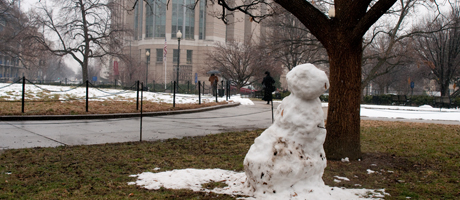By Jennifer Price
As blizzard conditions descended on the District last weekend, Washingtonians rushed to the nearest grocery store, grabbing anything they could find and prepared to be stuck inside for what could be days.
Lorenzo Norris, assistant professor of psychiatry and director of consult liaison psychiatry at George Washington University Hospital, explains the frenzy associated with a snow storm and gives advice on how best to cope with cabin fever.
Q: How do people generally feel about snow?
A: People are pretty receptive about the idea of snow when it’s around Christmas or the New Year, but usually after that most folks want the snow to go away. Because if you’re like most people here in the Washington area, you have a lot of things to do, you have a lot of traveling to do and a lot of expectations that you need to meet. And the snow just generally tends to get in the way. This is in contrast to children, who for the most part fundamentally love snow because it usually means they have a day off from school.
Q: When it comes to snow, where does the panic stem from?
A: The panic usually stems from the fact that we’re not used to getting heavy amounts of snow around here, and there are obstacles to traveling in the snow. It impedes your work day. It takes longer to do things, and there’s a very real concern about you getting into an accident or not being able to do the things you want to do.
There’s also a lot of panic around snow because we inherently lack control over the weather. We don’t necessarily know when it’s going to start or when it’s going to stop. And when we don’t have control over something, we have a tendency to go to the worst-case scenario. All this causes people to react with fear and panic.
Q: What’s the motivation behind people running out to the grocery store as though they are never going to be able to go again?
A: It’s anxiety concerning the unknown and fear of the worst. Because people aren’t used to this, they have a lot of anxiety regarding this so consequently they tend to underestimate their ability to deal with it and over prepare.
Q: How do Washingtonians typically react to snow?
A: Compared with other parts of the country, Washingtonians probably elevate their anxiety and fear factor above what you might see in Cleveland or Pennsylvania or Michigan. With Washingtonians, you have a group of folks with a number of high demands placed on them. Children aren’t going to be able to go to school. Certain work-related things can be shut down. Stores might close early.
Q: How does a person’s mood change when they are stuck inside for two days versus being stuck inside for four or more days?
A: For two days, people feel like they can cope. You have the TV. You can entertain yourself with books. But when it becomes longer than that, you can’t get outside and actually see sunlight and have your body naturally reset. You start to feel confined and that you are lacking a certain level of control.
Q: How big is the influence of the sun on people and their mood during the winter and a snow storm?
A: The sun is a huge influence on people’s moods. The sun is something that naturally allows us to set our internal body rhythms. It helps us determine when to sleep, when to wake. Consequently if that normal body rhythm is disrupted, people’s moods are going to be disrupted. They are going to have a tendency to be more moody. Certain folks actually suffer from a disorder called seasonal affective disorder.
Q: What is seasonal affective disorder?
A: Seasonal affective disorder, also known as SAD, is a disorder in which people are prone to have significant decreases in their mood where they enter into a clinical depression. Usually this would start in October or November and end in April or May. Seasonal affective disorder is directly related to one’s level of sunlight exposure. Women and those who live at more northern latitudes are most vulnerable.
The symptoms of SAD are almost like someone starting to hibernate. They start to crave carbohydrates. They start to sleep more. They feel like they lack energy. Usually how we treat SAD is having people use a light box in the morning that helps restore the body’s internal rhythms and elevate moods.
Q: Do you have any advice for people about how to deal with the snow?
A: Have your expectations in line. If you expect the worst, you are going to plan for the worst. If you expect for things to be a little inconvenient, then consequently you are going to be able to keep a better mood and a better outlook on things. When you’re dealing with the snow, realize that D.C. has an excellent public transportation system. We have a number of things in place to make sure the snow is removed quickly. Try and expose yourself to the sun. Make sure that even if there is a lot of snow, do what our kids do. Go out and have a little fun with it. Start sledding or build a snowman.


